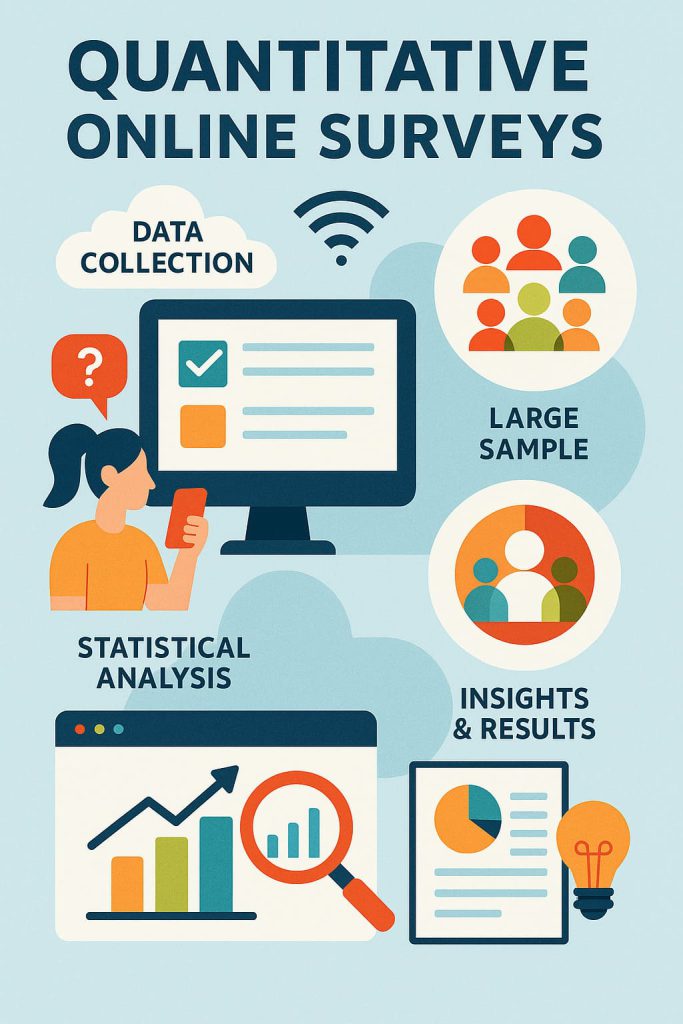Quantitative Online Surveys

While everyone’s obsessing over the latest AI tools or whatever buzzword is trending on LinkedIn this week, they’re overlooking one of the most powerful—yet frequently butchered—research methodologies available: properly designed quantitative online surveys. This unsexy, behind-the-scenes, methodical approach to gathering statistically significant insights is what separates companies that actually understand their markets from those just pretending to while slowly marching toward irrelevance.
Table of Contents
✅ Listen to this PODCAST EPISODE here:
The Untapped Power of Quantitative Online Surveys (When They Don’t Suck)
Approximately 70% of quantitative online surveys are so catastrophically poorly designed they generate actively misleading results. Not just useless data—harmful data that sends companies sprinting confidently in exactly the wrong direction.
They use leading questions that practically beg for certain answers, confusing scales that mean different things to different people, laughably inadequate sample sizes that wouldn’t pass a high school statistics class, or biased sampling methods that essentially guarantee predetermined conclusions. The end result? Data that belongs in the trash, not the boardroom.
But here’s the thing—They’re not just about counting things or creating pretty pie charts for PowerPoint decks. They’re about uncovering statistically valid patterns that reveal what people actually think, want, and do—not what your executive team sitting in their bubble wishes they would.
The benefits of properly executed quantitative online surveys are game-changing:
- Scalability that allows you to gather thousands of responses quickly and efficiently (try doing 1,000 interviews and get back to me in six months)
- Statistical validity that lets you make decisions with confidence intervals you can actually trust, not gut feelings dressed up as insights
- Segmentation capabilities that reveal how different customer groups behave differently—sometimes dramatically so
- Trend analysis when surveys are repeated over time, showing not just where you are but where things are heading
- Unbiased feedback that people might never provide in interview settings where social desirability bias runs rampant
It’s not about simply throwing some questions online and crossing your fingers. It’s about the rigorous, almost obsessive application of research methodology to ensure you’re gathering data that actually means something. Anything less is just expensive, time-consuming theater that creates the illusion of customer-centricity without any of the benefits.
Why Most Quantitative Online Surveys Generate Garbage Data
The problems aren’t mysterious or complex—they’re shockingly consistent across organizations of all sizes, and they’re killing the value of research everywhere I look:
- The Leading Question Disaster: Questions formulated with all the subtlety of a sledgehammer that subconsciously (or sometimes blatantly) push respondents toward certain answers. “How much did you enjoy our amazing service?” instead of “How would you rate our service?” It’s like asking, “How brilliant is my child?” instead of “How is my child performing in class?” Completely different answers.
- The Ambiguous Scale Trap: Using scales without clear definitions that leave respondents guessing. What exactly is a “4” on a 1-5 scale? Is it good? Great? Adequate? Nobody knows, including the people analyzing the data later. Even better, many surveys use different scales throughout—5 points here, 7 points there, 10 points elsewhere—creating a methodological nightmare.
- The Inadequate Sample Size Problem: Drawing major, company-altering conclusions from sample sizes so tiny they have no statistical validity whatsoever. “We surveyed 12 people, and 7 of them liked the feature, so 58% of our market will love it!” No. Just… no. That’s not how statistics works. Not even close.
- The Biased Sampling Error: Surveying only current customers (who obviously liked you enough to buy) and then making sweeping claims about “what the market wants.” That’s like asking only people at a Lady Gaga concert if they like Justin Bieber’s music, then concluding that everyone loves Lady Gaga. The logic is so flawed it hurts.
- The Survey Fatigue Failure: Creating surveys so painfully, unnecessarily long that respondents start selecting random answers just to finish the damn thing. By question 47, people aren’t giving thoughtful responses—they’re just clicking anything to make it stop. Yet those random clicks get treated with the same weight as their early, considered responses.
- The Correlation vs. Causation Confusion: Misinterpreting correlation in survey results as causal relationships, leading to completely wrong strategic conclusions. “People who rated us highly also own dogs! Dogs cause customer satisfaction! Free puppy with every purchase!”
The SCIENCE Framework: Designing Quantitative Online Surveys That Actually Work

Sample: Begin With Who, Not What
The single biggest mistake in quantitative online surveys is focusing first on questions rather than respondents. A brilliant survey sent to the wrong people is worthless. Actually, it’s worse than worthless—it’s misleading, because it creates false confidence.
It’s like creating the perfect fishing lure but casting it into a swimming pool. Doesn’t matter how good your lure is if there are no fish. Effective sampling requires:
- Crystal-clear definition of your target population (Who exactly are you trying to understand? Not vague personas, but specific, identifiable groups)
- Appropriate sample size calculations based on population size and desired confidence intervals (yes, there’s math involved—embrace it or get burned)
- Stratified sampling approaches when needed to ensure key segments are adequately represented (not just whoever shows up first)
- Rigorous screening questions that ensure only qualified respondents complete your survey (not just anyone who wants your gift card incentive)
- Sophisticated response validation methods to identify and eliminate garbage responses (because yes, people lie on surveys)
Clear: Design Questions That Are Impossible to Misinterpret
Once you’ve defined who should answer your survey, the question design phase of quantitative online surveys can begin. This is where subtle psychology matters enormously, and where most surveys go completely off the rails.
Here’s the brutal truth: writing good survey questions is HARD. Way harder than most people think. Effective question design includes:
- Using simple, direct language a 12-year-old could understand—no jargon, no technical terms, no corporate speak that makes sense only to your team
- Ruthlessly avoiding double-barreled questions that ask multiple things at once (“How satisfied are you with our product’s quality and customer service?”)
- Creating response options that are mutually exclusive and comprehensive—with no overlaps or gaps that leave respondents confused
- Balancing scales to avoid bias (e.g., having equal positive and negative options, not three positive choices and one negative)
- Actually testing your questions with representative users before full deployment (shocking how rarely this happens)
Integration: Combine Closed and Open Questions Strategically
بينما quantitative online surveys primarily focus on closed-ended questions that generate numerical data, strategic integration of open-ended questions can provide critical context. Effective integration approaches include:
- Using open-ended follow-ups to key quantitative questions
- Incorporating optional comment fields for unexpected insights
- Placing open-ended questions at the end to capture overall impressions
- Coding open-ended responses for quantitative analysis
- Using text analytics to identify patterns in open-ended responses
This balanced approach provides both statistical validity and the rich context needed to interpret those statistics correctly. One UX researcher I spoke with credited their product’s breakthrough success to a pattern identified in open-ended comments that would have been missed in purely quantitative analysis.
Engage: Design for Completion, Not Just Clicks
Survey abandonment is a massive problem in quantitative online surveys, and it creates serious data quality issues because those who abandon are often systematically different from those who complete. Effective engagement strategies include:
- Keeping surveys focused on essential questions only (ruthlessly eliminate “nice to know” items)
- Communicating realistic time expectations at the start
- Using progress indicators to reduce abandonment
- Varying question types to maintain interest
- Considering incentives for completion when appropriate
- Making mobile response simple and intuitive
Neutrality: Eliminate Bias at Every Level
Bias can creep into quantitative online surveys in dozens of subtle ways, compromising results without researchers even realizing it. Effective bias reduction includes:
- Randomizing question and answer option orders to prevent order effects
- Using neutral language that doesn’t telegraph “preferred” answers
- Avoiding loaded terms that carry emotional weight
- Separating brand identification from question wording when testing concepts
- Including “don’t know” or “not applicable” options when appropriate
Cross-Validate: Verify Through Multiple Methods
No single data source should drive major decisions. Effective quantitative online surveys are part of a broader research strategy. Effective cross-validation approaches include:
- Comparing survey results with actual behavioral data when available
- Conducting follow-up qualitative research to understand the “why” behind survey findings
- Testing surprising findings with additional targeted surveys
- Comparing results to industry benchmarks and previous research
- Looking for consistency across different segments and questions
Evaluate: Turn Data Into Actionable Insights
The final step transforms quantitative online surveys from academic exercises into business value. This is where far too many survey projects fail—they produce data, but not insights or actions. Effective evaluation includes:
- Statistical analysis appropriate to the data types collected
- Segmentation to identify meaningful differences between groups
- Prioritization frameworks that connect findings to business value
- Clear visualization of key findings for non-technical stakeholders
- Specific recommendations tied directly to survey results
Technical Considerations: Platforms and Tools for Robust Quantitative Research

Beyond methodology, the technical implementation of quantitative online surveys matters significantly:
Platform Selection: Beyond the Obvious Players
While SurveyMonkey and Google Forms dominate the conversation, professional researchers often require more robust platforms:
- كوالتريكس: Offers advanced logic, sophisticated question types, and powerful analytics
- Typeform: Provides exceptional user experience that can increase completion rates
- SurveyGizmo/Alchemer: Delivers excellent balance of power and usability
- LimeSurvey: Open-source option with extensive customization possibilities
- Decipher: Specializes in complex surveys for market research professionals
The right platform depends on your specific needs, but capability differences are significant. One research director I interviewed estimated that switching from basic to advanced platforms improved their data quality by approximately 30% through better logic, validation, and engagement features.
تحسين المحمول:
With over 50% of survey responses now coming from mobile devices, mobile optimization isn’t optional:
- Questions must display properly on small screens
- Selection mechanisms must work with touch interfaces
- Page load times must be lightning-fast
- Progress saving is essential for longer surveys
- Media elements must be compressed appropriately

Summary: Key Insights for Effective Quantitative Online Surveys
✅ Begin With Strategy: Effective quantitative online surveys start with clear research objectives and sampling strategy, not question writing
✅ Prioritize Response Quality: Design every aspect of the survey to maximize completion and thoughtful responses
✅ Eliminate Bias: Review questions, answers, and sampling methods to identify and remove sources of bias
✅ Integrate Methods: Use quantitative online surveys as part of a broader research ecosystem, not in isolation
✅ Apply Statistical Rigor: Ensure sample sizes and analytical approaches meet proper statistical standards
✅ Focus on Actionability: Design research to directly inform specific decisions, not just generate interesting data
✅ Validate Findings: Cross-check survey results against other data sources whenever possible
✅ Consider Response Context: Account for how, when, and where people will take your survey in the design
✅ Test Before Launching: Pilot surveys with representative respondents to identify problems before full fielding
✅ Maintain Neutrality: Separate the research function from those with vested interest in specific outcomes
What Makes SIS International a Top Resource for Quantitative Online Surveys
Navigating the complexities of quantitative online surveys isn’t something most organizations can figure out through trial and error. It requires specialized expertise that goes far beyond writing questions and sending emails. Here’s why serious organizations rely on SIS instead of continuing to produce misleading data:
- CUSTOMIZED APPROACH: Each quantitative research project demands a unique methodology—not a recycled template. The questions that matter for software companies are fundamentally different from those relevant to healthcare providers. The sampling approaches needed for B2B differ dramatically from consumer research. Generic “one-size-fits-all” survey frameworks miss the industry-specific nuances that often contain the most valuable insights. Firms like سيس الدولية للأبحاث build custom research frameworks for each industry they analyze.
- THE 40+ YEARS OF EXPERIENCE: There’s simply no substitute for having analyzed hundreds of competitive landscapes across decades. Firms with long-term specialized survey experience have pattern recognition capabilities that are impossible to develop internally without years of focused practice.
- THE GLOBAL DATABASES FOR THE RECRUITMENT: Finding the right respondents is often harder than designing the survey itself. Professional research firms maintain access to specialized respondent panels, pre-screened participant databases, and hard-to-reach populations that would take months or years for an individual company to develop. When you need to survey procurement officers in the pharmaceutical industry or parents of children with specific medical conditions, these specialized resources become invaluable.
- PROJECTS GET DONE FAST: Internal survey projects are notorious timeline-slippers. What starts as a “quick two-week analysis” becomes a three-month slog as internal priorities shift, questions get endlessly debated, and response rates disappoint. By the time results finally arrive, the decisions they were meant to inform have often already been made.
- AFFORDABLE RESEARCH: The fully-loaded cost of having internal staff conduct comprehensive quantitative analysis (including the opportunity cost of their regular responsibilities, the learning curve, and the inevitable mistakes) almost always exceeds the cost of hiring specialists who do this all day, every day.
- DEEP INDUSTRY EXPERTISE: Generic market research approaches miss the subtleties of industry-specific dynamics. What works in financial services research creates misleading results in healthcare. B2B technology requires different sampling approaches than consumer products. Effective survey research requires understanding the unique terminology, decision drivers, and success factors of specific industries. We maintain deep vertical expertise that generalist teams simply can’t match without years of specialized experience.
- ANALYTICAL RIGOR: The difference between data collection and actual intelligence is analytical rigor. Many internal teams stop at basic frequency counts and simple cross-tabs, missing the deeper patterns and insights that more sophisticated analysis would reveal. Professional researchers apply advanced statistical techniques including regression analysis, factor analysis, conjoint modeling, and segmentation approaches that transform raw responses into strategic insights your competitors will miss entirely.
FAQ: Quantitative Online Surveys
What sample size do I need for statistically valid results?
This question cuts to the heart of what makes quantitative online surveys different from casual polls or feedback forms: statistical validity. The answer depends on several key factors:
- Population size: The total size of the group you’re studying (though this becomes less important as numbers get large)
- Desired confidence level: Typically 95% or 99%, indicating how certain you need to be that your results represent the true population
- Acceptable margin of error: How precise your estimates need to be (±3% vs. ±5%, for example)
- Expected response distribution: How varied you expect answers to be
- Analysis plans: If you need to analyze subgroups, sample sizes must increase accordingly
While online calculators can provide basic estimates, a more nuanced approach considers:
- For general population studies, samples of 1,000-2,000 typically provide good balance between cost and precision
- For B2B research with smaller total populations, smaller samples may be adequate (but rarely below 100)
- Segmentation analysis requires sufficient sample in each segment (minimum 50-100 per segment)
- Longitudinal studies tracking changes over time require larger samples to detect subtle shifts
- Rare populations or characteristics require larger overall samples to ensure adequate representation
How can we ensure respondents are being truthful in online surveys?
The gap between what people say and what they actually do represents one of the most significant challenges in quantitative online surveys. Several methodological approaches can help ensure more truthful responses:
- Attention check questions: Including questions with known answers to identify respondents who aren’t reading carefully
- Trap questions: Adding logical impossibilities to identify “straight-liners” and bots
- Response time analysis: Flagging suspiciously fast completions
- Consistent response patterns: Looking for contradictions in answers to related questions
- Indirect questioning: Using projective techniques for sensitive topics
- Anonymity assurance: Clearly communicating how data will be used and protected
- Incentive design: Structuring incentives to reward thoughtful completion rather than just any completion
- Open-ended validation: Including open text fields that allow assessing response quality
- Panel quality measures: Working with research panels that use robust validation methods
- Behavioral validation: When possible, comparing survey responses to actual behavioral data
How do you design surveys to minimize bias while maximizing completion?
This question hits the central tension in quantitative online surveys that nobody wants to talk about: you need both high-quality responses AND enough responses to be statistically valid. These competing goals often pull in opposite directions and require some tough design decisions.
Let me share some battle-tested approaches that actually work in the real world, not just in textbooks:
- Length optimization: Aim for 5-7 minutes for general audiences, maybe 8-10 for highly engaged stakeholders. Every question you add reduces completion rates and response quality.
- Progress indicators: People hate uncertainty. Show respondents how far they’ve come and how much is left. It’s the survey equivalent of those “5 miles to next rest stop” highway signs. Without them, abandonment rates skyrocket because people have no idea if they’re facing 3 more questions or 30.
- Question sequence psychology: Start with engaging, easy questions before moving to more complex or sensitive ones. Hit them with demographic questions or complex matrix tables right away, and watch your completion rates plummet. It’s like a first date—don’t lead with your most challenging qualities.
- Mobile-first design: Over 60% of surveys are now completed on mobile devices, yet I still see surveys designed as if everyone’s sitting at a desktop with a 27-inch monitor. Matrix questions with 15 rows and 7 columns are virtually impossible to complete on a phone without making errors. Design for thumbs, not mouse pointers.
- Visual design principles: Use clean, consistent layouts that reduce cognitive load. Every time respondents have to figure out how a question works, you’re burning their limited attention span on your survey mechanics instead of their thoughtful responses.
- Neutral framing: Present truly balanced perspectives in question wording. Don’t ask “How much did you enjoy our service?” Ask “How would you describe your experience with our service?” The difference in results will shock you.
- Response scale standardization: Use consistent scales throughout to avoid confusion. Don’t jump from 5-point to 7-point to 10-point scales—it forces respondents to recalibrate their mental models with each change, leading to inconsistent responses.
- إضفاء الطابع الشخصي: Use the respondent information you already have to customize question relevance. Nothing screams “we don’t care about your time” like asking questions you should already know the answers to or that clearly don’t apply.
- Forced vs. optional questions: Requiring responses for every single question is a guaranteed way to get fake answers when people don’t have an opinion but can’t proceed without selecting something. Make non-essential questions optional and watch your data quality improve.
- Incentive structure: Provide appropriate compensation without creating response bias. Too little incentive and only people with strong opinions respond. Too much and you get professional survey-takers who speed through providing garbage data just to collect rewards.
How do you effectively analyze and present quantitative survey results?
Data collection is only the beginning. The true value of quantitative online surveys emerges through proper analysis and presentation:
- Start with cleaning: Removing incomplete, inconsistent, or invalid responses before analysis
- Apply appropriate statistics: Using the right tests based on data types and distributions
- Segment meaningfully: Analyzing differences among groups that matter to decision-making
- Test for significance: Determining whether differences represent real patterns or random variation
- Look beyond averages: Examining distribution patterns, not just central tendencies
- Build explanatory models: Using regression and other techniques to understand drivers of key outcomes
- Present visually: Using data visualization principles to make patterns immediately apparent
- Tell the story: Structuring findings in a narrative that connects to business questions
- Highlight actionability: Emphasizing findings that suggest clear next steps
- Connect to other data: Integrating survey results with other business intelligence
How frequently should we conduct quantitative online surveys?
The appropriate cadence for quantitative online surveys depends on several business factors:
- Rate of market change: Fast-evolving markets require more frequent measurement
- Decision cycles: Align survey timing with when key decisions are made
- Seasonality considerations: Account for cyclical patterns in your industry
- Response burden: Avoid over-surveying the same populations
- Trend analysis needs: Determine how frequently you need to measure changes
- Resource constraints: Balance ideal frequency with practical limitations
Effective survey planning typically includes:
- Tracking studies: Regular measurements of key metrics (often quarterly or bi-annually)
- Pulse surveys: Brief, frequent surveys on specific topics (monthly or even weekly)
- Deep dives: Comprehensive studies on major strategic questions (annually or during planning cycles)
- Triggered surveys: Research activated by specific events or thresholds
- Rotating panels: Using different respondent groups to reduce survey fatigue
How do you integrate quantitative online surveys with other research methods?
The most sophisticated research programs use quantitative online surveys as one component of a coordinated mixed-methods approach:
- Sequential integration: Using qualitative research to develop hypotheses that quantitative surveys then test at scale
- Parallel triangulation: Conducting multiple research methods simultaneously to compare findings
- Nested approaches: Embedding qualitative elements within quantitative surveys and vice versa
- Iterative modeling: Using each method to refine the questions asked in subsequent research
- Cross-validation: Comparing findings across methodologies to identify consistencies and contradictions
- Method-appropriate assignment: Selecting research approaches based on specific question types
- Comprehensive synthesis: Integrating insights from all methodologies into unified recommendations
موقع منشأتنا في نيويورك
11 إي شارع 22، الطابق 2، نيويورك، نيويورك 10010 هاتف: 1(212) 505-6805+
حول سيس الدولية
سيس الدولية يقدم البحوث الكمية والنوعية والاستراتيجية. نحن نقدم البيانات والأدوات والاستراتيجيات والتقارير والرؤى لاتخاذ القرار. نقوم أيضًا بإجراء المقابلات والدراسات الاستقصائية ومجموعات التركيز وغيرها من أساليب وأساليب أبحاث السوق. اتصل بنا لمشروع أبحاث السوق القادم.



